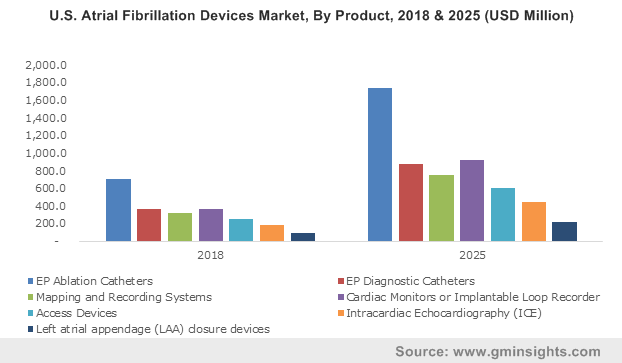U.S. atrial fibrillation devices market to garner substantial proceeds over 2019-2025, high prevalence of the ailment in Europe to drive industry growth
Publisher : Fractovia | Published Date : 2019-05-30Request Sample
Rapid technological advancements in healthcare & increasing robustness of healthcare infrastructures has led the atrial fibrillation devices market expansion in recent years, establishing it as a fast-rising, highly remunerative avenue of investment.
U.S. Atrial Fibrillation Devices Market, By Product, 2018 & 2025 (USD Million)

Atrial fibrillation, also known as AFib, is known heart condition where the heart’s upper chambers beat` irregularly & rapidly, causing blood clots to form in the heart’s LAA (left atrial appendage), leading to strokes.
According to Boston Scientific, due to the nature of the condition, a person suffering from AFib is five times more likely to experience a stroke than an individual with a regular heartbeat. The condition’s impact is further magnified by the fact that AFib is the world’s most commonly occurring sustained arrhythmia.
In 2010, the American College of Cardiology estimated that AFib affects approximately 33.5 million individuals globally with over five million new cases being diagnosed on an annual basis. This exponential growth has warranted the proliferation of atrial fibrillation devices across the world, ranging from monitoring devices such as implantable loop recorders & cardiac monitors to actual treatment devices like the Watchman™ that seals off the LAA to prevent strokes. Therefore, the increasing product demand has been fostering the economic growth of the atrial fibrillation devices market.
Atrial fibrillation devices market | Impact of AFib’s growing prevalence in the U.S.
The U.S. atrial fibrillation devices market is known to be one of the largest in the world. Several factors are responsible for bringing the U.S. to this prominent spot, including the nation’s advanced healthcare infrastructure and its rising geriatric population.
The Numbers: According to the Centers for Disease Control and Prevention (CDC), an estimated 2.7 to 6.1 million Americans suffer from AFib with the elderly accounting for a bulk of the demographic; 2% of the U.S. population aged below 65 has AFib as opposed to 9% aged above 65, as the risk of developing AFib increases as a person ages.
The Costs: The CDC further estimated that approximately 750,000 hospitalizations occur annually due to AFib with the condition contributing to over 130,000 deaths every year. The heart condition costs the U.S. an estimated $6 billion annually as medical costs for an AFib patient are $8,705 higher each year than they are for people not suffering from AFib.
The Consequences: To mitigate the adverse financial impact of AFib cases on the nation’s economy, the healthcare industry is rapidly adopting new atrial fibrillation devices, giving several technological firms the impetus to enter the healthcare industry through innovative devices.
A prominent example is the QardioCore; a smartphone-supported ECG/EKG monitor that is worn like a fitness device to monitor heartbeats. In fact, driven by such innovations & the presence of a well-established healthcare sector, the U.S. atrial fibrillation devices market is expected to grow with a 13.9% CAGR in forthcoming years.
Atrial fibrillation devices market | Impact of AFib’s growing prevalence in Europe
A 2011 study conducted by the National Center for Biotechnology Information (NCBI) discovered that AFib is more likely to affect people of European ancestry than people of other descent.
The outcome of the study is further corroborated by a Bayer HealthCare Pharmaceuticals report that termed AFib related stroke as a major health problem faced by Europe today and that 15% of the strokes in the region are caused by atrial fibrillation.
The Numbers: According to Bayer HealthCare Pharmaceuticals, atrial fibrillation presently affects more than 10 million Europeans. However, this number is projected to rise sharply, reaching the 25-30 million-mark by 2050, due to the continent’s ageing population.
The Costs: The financial strain inflicted by strokes the on European nations is considerably large with a 2010 census putting the cost at approximately €64 billion. Add to the fact that 15% of strokes are caused by AFib and that they are typically more severe than non-AFib-related strokes, they cost the European economy approximately €10 billion annually.
The Projection: As the condition could easily manifest without showing any symptoms, several European countries, in an effort to detect AFib, are actively checking patients aged 65 & higher for irregular heartbeats and referring them to an electrocardiogram. Such active screening programs greatly improve the chances of detecting AFib in patients while also fueling the sale of atrial fibrillation devices across hospitals & medical centers.
Aided by similar programs and the presence of highly-developed & competent healthcare systems, the Europe atrial fibrillation devices market is slated to record substantial growth over the forecast timeframe.
Propelled by the condition’s rising prominence in the western hemisphere, especially Europe and the U.S., the atrial fibrillation devices market revenue graph is slated to depict substantial gains over the upcoming years. Reports estimate that the overall size of the atrial fibrillation devices market would be surpassing the valuation of $12.5 billion by 2025.